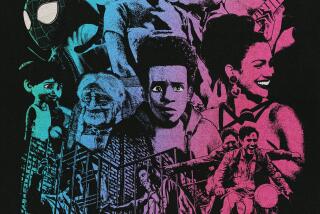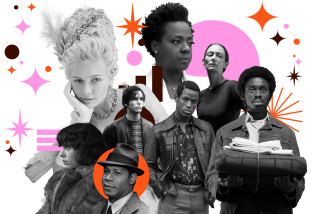Movie review: âDjango Unchainedâ is Tarantino unleashed
Here is the particular brilliance of Quentin Tarantino: He can rip a horrific page out of history â for his latest, âDjango Unchained,â slavery in the antebellum South â put it through his favorite grindhouse mill, kick in biting comedy whose sheer audacity and searing irony demands laughter, and yet ... and yet ... never for a moment diminish or let us forget the brutal reality.
What the writer-director did so caustically to Nazis in 2009âs âInglourious Basterdsâ â scalping (literally) and roasting (comically) â was apparently just a warm-up.
In âDjango,â Tarantino is a man unchained, creating his most articulate, intriguing, provoking, appalling, hilarious, exhilarating, scathing and downright entertaining film yet. Even given the grand tradition of artists using their work for sharp social rebukes â Mel Brooksâ genius swipe at Nazism in âThe Producers,â for one âTarantinoâs mash-ups between the unconscionable inhumanity of others and his outrageous riffs on the matter defy comparison.
PHOTOS: âDjango Unchainedâ - Quentin Tarantino, Jamie Foxx, Christoph Waltz
The four horseman of his apocalypse â Jamie Foxx, Christoph Waltz, Leonardo DiCaprio and Samuel L. Jackson â come with guns and metaphors blazing. Their archetypes serve to mark out the battleground Tarantino bloodies with a vengeance that surpasses everything else in his archive, including âKill Billâ volumes 1 and 2.
Django (Foxx), the slave/freeman; Dr. King Schultz (Waltz), the liberator; Calvin Candie (DiCaprio), the abusive plantation owner; and Stephen (Jackson), the sycophant house slave, provide the filmâs chaos and catharsis with every rise and fall of their clashes. The indictment comes with each stroke of the lash â and there are countless of them â none harder to watch than the whipping of Broomhilda (Kerry Washington), Djangoâs wife.
With Tarantino thereâs always a very specific artistic influence informing the theatrics on screen, and in âDjangoâ the style is a priceless cut at spaghetti westerns. The primary homage is to the two Sergios (Corbucci, who introduced âDjangoâ into the movie lexicon in 1966, and Leone, who created a fistful of classics). Whether it was nothing more than a creative choice or a latent desire to extend the Italian dominance of the genre across generations and borders, Tarantino has never seemed more comfortable in the saddle.
The film begins with a line of slaves shackled together on a forced march across a desert that is scorching hot by day, frigid by night. Title cards, which are dropped in periodically, their size a clue to significance, starts the timeline at two years before the Civil War. The arrival of Dr. Schultz, ostensibly a dentist, a giant tooth bobbing atop his coach, changes the course of everyoneâs life. He is actually a bounty hunter looking to acquire a slave named Django to identify the three murdering-thieving Brittle brothers, who mask their illegal activity as overseers for hire and have a substantial price on their heads.
Best of 2012: Video Games | Movies | TV | Music | Jazz
Schultz puts forth his proposition with such elegant erudition that it rarely fails to nettle nearly anyone he encounters. This first group, a matted bunch of slavers who spit tobacco and growl at Schultz to âtalk English,â are typical. The cultural clash becomes one of the filmâs smartest running gags, and Waltzâs delivery, as slick as it is sly, is possibly better than his Nazi colonel in Tarantinoâs âBasterds,â which won him an Oscar.
DiCaprioâs villain, who turns up later, is equally exceptional in radically different ways. It is one of the filmâs conundrums for Foxx, technically the leading man. He does a fine job of melding his newly freed slave into a masterful gunslinger, with all the swagger and retribution that suggests. But there are so many finely crafted performances around him, itâs hard for him to rise above the rest.
The side proposition Schultz makes with Django is his freedom once he identifies the Brittles. Over the many campfires that follow, life stories are traded, a friendship is formed and a partnership in the bounty-hunting game is hammered out: âI get paid to shoot white men?â
As satisfying as that is â for us as well â what Django wants most is to buy the freedom of his beloved Broomhilda, their marriage illegal in those times.
Though the bounty-hunting business is filled with scoundrels, slavery is the central villain here. Schultz and Django encounter the many faces of that evil in the course of their travels. A few lend themselves to slapstick, like the birth of the KKK. Others â such as the rarefied world of the bordello beauties and the softer life of the house slaves â get a more ironic treatment. But mostly the director chooses to expose the cruelty. The various types of torture used to punish runaways â attack dogs, hot boxes and, of course, the whipping posts â are unsparingly depicted.
In Case You Missed It: Golden Globe nominations
Though badness abounds, evil incarnate thrives in particularly insidious ways in Candyland, a huge Mississippi planation run by its pampered potentate, Calvin. Never has DiCaprio been more sinister than he is here â sarcasm dripping in every honeyed word, insolence flickering in his eyes, hate in his heart. The to-the-death sport of Mandingo fighting is his current obsession and the stage for some of the most difficult scenes to stomach. When Schultz discovers Broomhilda has been sold to Candyland, a major ruse around the sport is concocted in their bid to buy her freedom, and the various complications drive the back half of the film.
Since this is quintessential Tarantino, there is never much time between blood-spilling. Somehow, he and cinematographer Robert Richardson have created a palette that connects the visual sensibility of the Old South and the Old West seamlessly â the blood is just as red and bountiful in both places.
One of Tarantinoâs great strengths, and weaknesses, as a filmmaker is the way he falls in love with his actors and his ideas. It makes him reluctant to let go of certain bits and means that others go on too long â often itâs the highly choreographed action scenes that he canât bear to end.
This pushes âDjangoâ close to the three-hour mark, and there are a couple of spots when you are sure youâve just witnessed a bang-up ending only to find Tarantino setting things up for another round. Editor Fred Raskin, who has worked on a number of the directorâs projects, must have the patience of Job. I can just imagine the pained expression Tarantino gets when heâs forced to make cuts â itâs there in his cameo, which might have been a place to start.
--------------------------
âDjango Unchainedâ
MPAA rating: R for strong graphic violence throughout, a vicious fight, language and some nudity
Running time: 2 hours, 45 minutes
Playing: In general release
PHOTOS AND MORE
VIDEO: The making of âArgo,â âLes Mizâ and more
VIDEO: Holiday movies - A video guide
PHOTOS: NC-17 movies: Ratings explained
More to Read
Only good movies
Get the Indie Focus newsletter, Mark Olsen's weekly guide to the world of cinema.
You may occasionally receive promotional content from the Los Angeles Times.











